Dinger's Aviation Pages
NOTE THIS PAGE IS AN ARCHIVE - THE INFORMATION ON IT HAS NOT BEEN UPDATED SINCE 1995.
HARRIER
Back in 1995 I issued a DOS program on floppy disk called "RAF FASTJETS" which was written using IBM's "LINKWAY" product. All the information on this page is taken from that program, none of the data has been updated since 1995. The photos are from the collection of John Edwards.
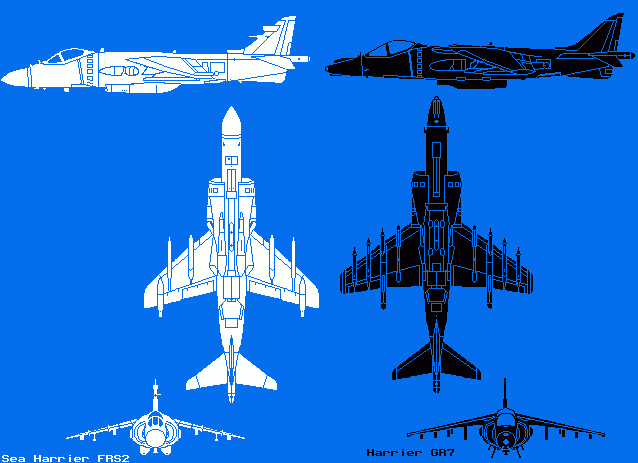
The Harrier is often cited as an example of British ingenuity and indeed this amazing aircraft is the product of much dedicated work by British Aerospace (and the earlier Hawker Siddeley company) along with Rolls-Royce. However the early Harrier development was largely paid for by the U.S. taxpayer via the Mutual Weapons Development Program (MWDP) and the starting point for the design of the Harrier's Pegasus engine was the work of Michel Wibault, a French engineer.
In the late 50s, there was much research going on to build vertical-take-off jet aircraft and many companies in Europe and the US started projects that resulted in prototypes that flew in the 1960s. Most of these aircraft used separate engines for downward and forward thrust.
Michel Wibault envisaged a jet engine that drove four air blowers like enormous hair-dryers that could be rotated to provide lift. Gordon Lewis at Rolls-Royce and Ralph Hooper at Hawker developed this idea into the Pegasus engine which made the Harrier possible.
Working under the control of Sir Sydney Camm, who had designed the Hurricane fighter of World War Two, Hooper's team designed the P1127 prototype which in turn led to the Kestrel series which was used to evaluate the new technology in a combat role.
The aim at this time was to build a supersonic VSTOL fighter to meet the needs of the RAF and Fleet Air Arm. This project, called P1154, was cancelled by the Labour government in 1965. Instead, the P1127 was ordered in combat form as a replacement for ground-attack Hawker Hunters of the RAF. At first, the RAF was not very pleased to have this "political animal" foisted upon them, but then came the Arab-Israeli War of 1967 when the Arab Airforces were destroyed on their airfields within the first hours of combat. All of a sudden, squadrons of Harriers hidden away in woods looked the only way to survive a Warsaw-Pact surprise attack. The RAF found itself converted to the VSTOL creed.

The GR Mk 1 Harrier with a neatly pointed nose gave way to the GR3 with a more bulbous one housing a laser-marked target seeker. The Harrier was one of the first strike aircraft to have an inertial navigation system linked to a moving map display to help the pilot keep on course.
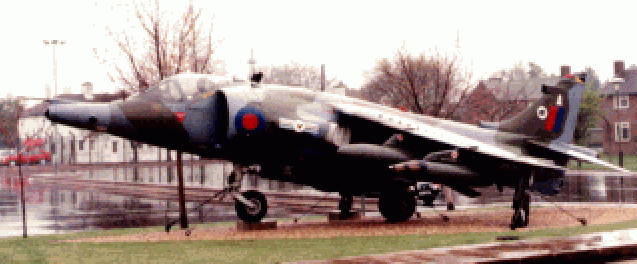
The Harrier was adopted by the US Marine Corps as the AV-8A. The advantages of the Harrier for the support of amphibious operations were highlighted in the Falklands War and the USMC makes full use of these abilities.
The AV-8A and GR3 did have a couple of problems. They had a short-range and their load carrying capability was only 5,000 lb (2,268 Kg); low compared with most modern strike aircraft.
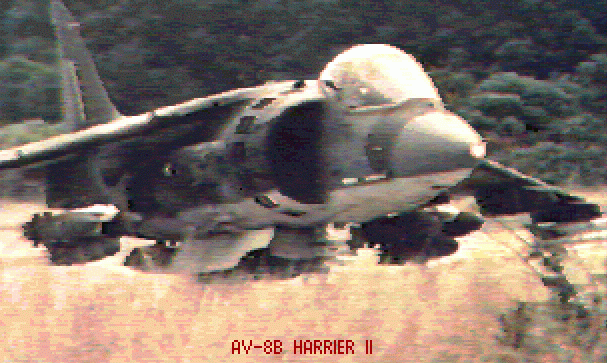

McDonnell Douglas had gone into partnership with British Aerospace to build the AV-8A for the USMC. They rebuilt an AV-8A with a new wing made of carbon composite material. This improved the range and nearly doubled the amount of weapons the aircraft could carry. This new model (the AV-8B) also had improved avionics, an angle-rate bombing system, Forward-Looking Infra-Red (FLIR), built-in radar warning sensors and chaff dispensers. British Aerospace designed a leading-edge extension that improved the turn rate for greater maneouvrability.

The AV-8B was built by British Aerospace as the GR5 for the RAF. This started to enter service in 1988. The addition of FLIR and the added ability of the pilot to use night-vision goggles resulted in the GR7 which entered RAF service in 1990. All GR3 and GR5 aircraft have now been withdrawn or upgraded so that the RAF now operates a fleet of GR7 Harriers with some T4 and T10 two-seat trainers.
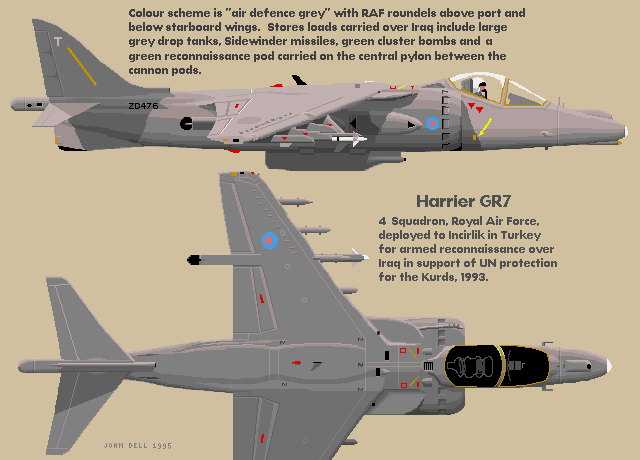
The USMC has started to upgrade its AV-8Bs with the APG-65 radar to give them enhanced night attack capability as well as opening up the air defence roll to them.
The Royal Navy ordered a naval version of the Harrier in 1975, It first flew in 1978. Known as the Sea Harrier FRS1 its primary task was to be the defence of the fleet with strike and reconnaissance as secondary duties. To allow it to see enemy aircraft a Ferranti Blue Fox radar was fitted in an elongated nose that folds to reduce length for stowage on the Royal Navy's small carriers. To give the pilot better visibility for air combat the cockpit is raised (a feature of the AV-8B and GR7 as well).
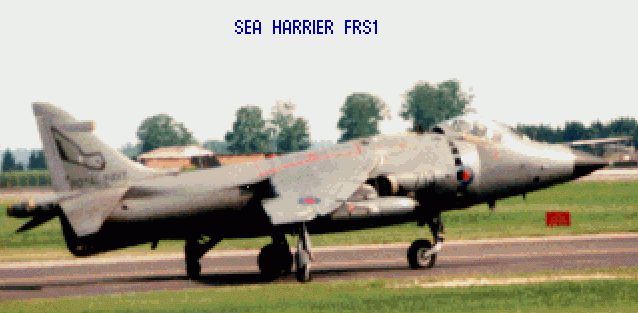
In the Falklands War of 1982 the presence of the Sea Harrier FRS1 on the ski-jump equipped carriers Hermes and Invincible proved decisive. They shot down 24 Argentine aircraft with the then-new AIM 9L version of the Sidewinder missile and damaged several more with fire from their twin 30mm cannon. Not one Sea Harrier was lost in combat with Argentine aircraft. Some years earlier British Aerospace, keen for overseas sales, had demonstrated a Harrier on board the Argentine aircraft carrier, 'The Twenty-Fifth of May'. The Argentine response was: "No good."
The Indian Navy also operate the Sea Harrier in its FRS MK52 form which differs from the FRS1 in having a different oxygen system and the ability to fire the French Matra Magic air-to-air missile.
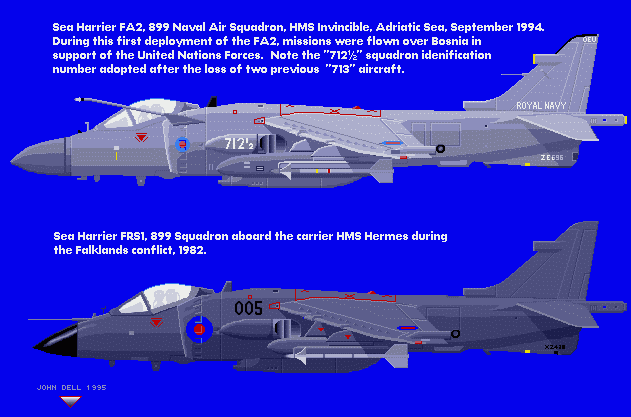
Both Italy and Spain operate Harriers from aircraft carriers. Italy has AV-8Bs while Spain uses a mixture of AV-8Bs and the earlier AV-8S which is based on the AV-8A. Without radar, these aircraft are restricted in the air defence role and so both countries are keen to upgrade to the new American APG-65 radar.
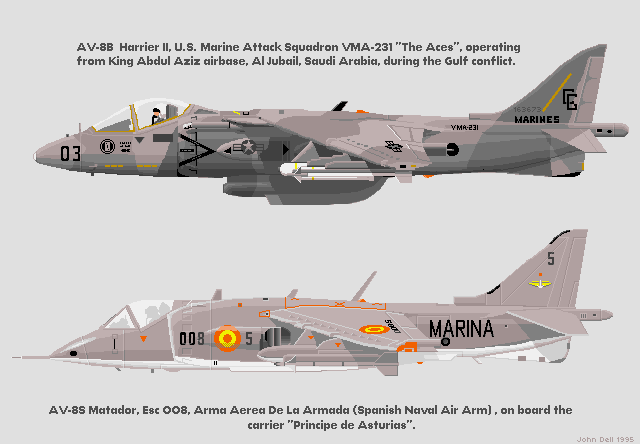
Meanwhile, the Royal Navy has now got itself a new improved Sea Harrier. The FA2 started operating with the fleet in 1994. The radar has been upgraded to the Ferranti Blue Vixen system which has lookdown-shootdown capability along with the ability to engage 4 targets with AIM-120 missiles at the same time. The FA2 represents a giant leap in the ability of the Royal Navy to defend itself from air attack. As a strike aircraft, the FA2 is also a big improvement on the FRS1. The Blue Vixen radar can pick up ships at longer range and launch attacks with Sea Eagle and Alarm missiles.
The Harrier remains the West's only Vertical/Short Take-Off and Landing combat aircraft. The only other V/STOL fighter to go into production is the Russian Yak-38 naval fighter.
PERFORMANCE
GR7 and AV8-B
Max Speed 660 mph (1,065 km/h) at sea level, 600 mph (966 km/ph) at 36,000 ft.
Tactical radius at low level with full bombload and 1 hour loiter is 103 miles. With drop tanks, no loiter and 3,500 lb of bombs the combat radius is 553 miles (889 km). With maximum external fuel tanks the ferry range is 2,015 miles, this can be extended with in-flight refueling using the built-in refueling probe which retracts when not in use.
SEA HARRIER FA2
Max speed 720 mph (1,160 km/h) at 1,000 ft (305 m). 607 mph (977 km/h) at 36,000 ft.
Combat radius to intercept a high flying target is about 480 miles (750 km). It can stay on Combat Air Patrol (CAP) some 100 miles from its carrier for over 1.5 hours.
On an attack mission with two Sea Eagle anti-ship missiles the radius of action would be 230 miles (370 km). On the Sea Harrier the refueling probe is a bolt-on non-retracting device.
ENGINES
GR7 and AV-8B
Rolls-Royce Pegasus 106 turbofan with vectored thrust giving 21,750 lb thrust.
Sea Harrier FA2
Pegasus 106 giving 21,500 lb thrust.
The Rolls-Royce Pegasus series started with the 101 used in the Harrier GR1 with 19,000 lb thrust. The Harrier GR1A used the Pegasus 102 with 20,500 lb. Then came the 103 used in the GR3 and AV-8A with 21,500 lb thrust.
In this remarkable engine the turbojet drives additional fans at the front of the engine (hence making it a turbofan) whose thrust is fed via two vectored outlets to provide lift. Then the hot exhaust thrust of the turbojet itself is vectored via two rear outlets to add to the thrust of the first pair. This means the entire power of the engine can be used to provide lift.
ARMAMENT
GR Mk 7
The GR7 can carry up to 9,200 lb (4,173 Kg) of external stores on 9 pylons. Gun armanent consists of two 25mm cannon in ventral pods. Amongst the weapons carried by RAF Harriers are normal "iron " bombs, Laser Guided Bombs (LGBs), BL755 cluster bombs, AIM-9 Sidewinder missiles and unguided rockets in pods. A photo-reconnaissance pod can be carried on the centre-line pylon between the guns.
AV-8B
The USMC Harriers have only a single GAU-12 cannon in the port ventral pod with the ammunition for it fed from the starboard pod. There are only 7 pylons for weapons. Along with normal bombs the CBU Cluster bomb family is a favourite weapon of USMC Harriers. Also used are unguided rockets and the Maverick air to surface missile. Like RAF Harriers they carry Sidewinder missile for self-defence.
FA2
The Fleet Air Arm Sea Harrier can carry two ventral pods each with a 30 mm cannon. In place of these it can carry two of the new AIM-120 air-to-air missile under the fuselage, with another two AIM-120s under the wings, a total complement of four of these formidable missiles. There are four pylons under the wings which can carry the weapons used by the RAF GR MK7 version plus Sea Eagle anti-ship missiles or Alarm anti-radar missiles. In normal use two of these wing pylons would be taken up by fuel tanks.
FRS1
The earlier FRS1 Sea Harrier's weapon-load was much like that of the new FA2 except that the AIM-120 missile could not be carried.
USERS
US MARINE CORPS.
AV8B and TAV-8B. The USMC operate the AV8B Harrier II from US Navy aircraft carriers, amphibious assault ships and land bases.
ROYAL AIR FORCE.
GR7, T10 and T4. Operated from bases in the UK and Germany.
FLEET AIR ARM
FRS1, F/A2 and T4. Operated from the carriers Invincible, Illustrious and Ark Royal.
ARMA AEREA DE LA ARMADA
(Spanish naval air arm).
EAV-8B, AV8-S and TAV-8S. Operated from the carrier Principe de Asturias.
INDIAN NAVY
FRS51 and T60. Operated from the carrier Vikrant.
AVIAZIONE PER LA MARINA
MILITARE ITALIANA
(Italian naval air arm).
AV-8B and TAV-8 . Operated from the carrier Guiseppe Garibaldi.
NOTE THIS PAGE IS AN ARCHIVE - IT HAS NOT BEEN UPDATED SINCE 1995. THE HARRIER IS NO LONGER IN RAF SERVICE.
Updated info:
The Harrier left RAF service in 2010 / 2011.
The Harrier left Indian Navy service in 2016.
As of 2019 it continues in use by the US Marine Corp, the Spanish Navy and the Italian Navy. All plan to replace the Harrier with the F-35.
